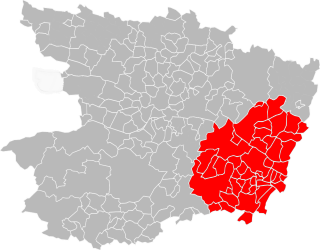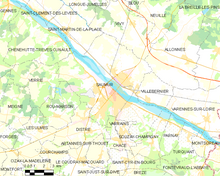
Maine-et-Loire is a department in the Loire Valley in the Pays de la Loire region in Western France. It is named after the two rivers, Maine and the Loire. It borders Mayenne and Sarthe to the north, Loire-Atlantique to the west, Indre-et-Loire to the east, Vienne and Deux-Sèvres to the south, Vendée to the south-west, and Ille-et-Vilaine to the north-west. It also borders Ille-et-Vilaine in the north for just 20 yards (19 m), France's shortest department boundary. Its prefecture is Angers; its subprefectures are Cholet, Saumur and Segré-en-Anjou Bleu. Maine-et-Loire had a population of 818,273 in 2019.

Saumur is a commune in the Maine-et-Loire department in western France.

The Loire Valley, spanning 280 kilometres (170 mi), is a valley located in the middle stretch of the Loire river in central France, in both the administrative regions Pays de la Loire and Centre-Val de Loire. The area of the Loire Valley comprises about 800 square kilometres (310 sq mi). It is referred to as the Cradle of the French and the Garden of France due to the abundance of vineyards, fruit orchards, and artichoke, and asparagus fields, which line the banks of the river. Notable for its historic towns, architecture, and wines, the valley has been inhabited since the Middle Palaeolithic period. In 2000, UNESCO added the central part of the Loire River valley to its list of World Heritage Sites.

The Château de Montsoreau is a Flamboyant Gothic castle in the Loire Valley, directly built in the Loire riverbed. It is located in the market town of Montsoreau, in the Maine-et-Loire département of France, close to Saumur, Chinon, Fontevraud-l'Abbaye, and Candes-Saint-Martin. The Château de Montsoreau is situated at the confluence of two rivers, the Loire and the Vienne, and the meeting point of three historical regions: Anjou, Poitou, and Touraine. It is the only château of the Loire Valley built directly in the Loire riverbed.

Pays de la Loire is one of the eighteen regions of France, located on the country's Atlantic coast. It was created in the 1950s to serve as a zone of influence for its capital and most populated city, Nantes, one of a handful of French "balancing metropolises". In 2020, Pays de la Loire had a population of 3,832,120.

Gennes is a former commune in the Maine-et-Loire department in western France. On 1 January 2016, it was merged into the new commune of Gennes-Val-de-Loire.

The First Army was a field army of France that fought during World War I and World War II. It was also active during the Cold War.

Montsoreau is a commune of the Loire Valley in the Maine-et-Loire department in western France on the Loire, 160 km (99 mi) from the Atlantic coast and 250 km (160 mi) from Paris. The village is listed among The Most Beautiful Villages of France and is part of the Loire Valley UNESCO World Heritage Site.

The arrondissement of Saumur is an arrondissement of France in the Maine-et-Loire departement in the Pays de la Loire region. It has 52 communes. Its population is 135,333 (2016), and its area is 1,968.0 km2 (759.8 sq mi).

The Communauté d'agglomération Saumur Val de Loire is an intercommunal structure in the Loire Valley gathering 45 communes including Saumur. It is located in the Maine-et-Loire département, in the Pays de la Loire région, western France. It was formed on 1 January 2017 by the merger of the former Communauté d'agglomération de Saumur Loire Développement, the Communauté de communes Loire Longué, the Communauté de communes du Gennois and the Communauté de communes de la région de Doué-la-Fontaine. Its area is 1233.7 km2. Its population was 99,236 in 2018, of which 26,599 in Saumur proper.

The Pont de Grenelle-Cadets de Saumur, formerly known as Pont de Grenelle is a bridge that crosses the Seine River in Paris, France. It connects the city's 15th and 16th arrondissements, and passes through the Île aux Cygnes. Constructed of steel, it is a girder bridge. The current bridge was constructed in 1966, replacing an earlier bridge that had stood since 1873. The bridge passes behind a replica of the Statue of Liberty.
The 1st Army Corps was first formed before World War I. During World War II it fought in the Campaign for France in 1940, on the Mediterranean islands of Corsica and Elba in 1943 - 1944 and in the campaigns to liberate France in 1944 and invade Germany in 1945.
The Army of the Coasts of La Rochelle was an army of the French Revolution which was created on 30 April 1793 and responsible for defending a region from the mouth of the Loire River south to the Gironde. Despite its relatively short existence, the army fought numerous battles during the War in the Vendée including Thouars, Fontenay-le-Comte, Saumur, First Châtillon, Vihiers, Luçon, Chantonnay, Coron and Saint-Fulgent. Many of the battles resulted in Republican defeats at the hands of the Vendean Royalists. Of the two principal army commanders, Armand Louis de Gontaut, Duke of Biron was dismissed and later executed by guillotine while Jean Antoine Rossignol was a political appointee who was generally acknowledged to be incompetent. The army was absorbed by the Army of the West on 5 October 1793.
The École de cavalerie is a French military training establishment at Saumur in Western France. Originally set up to train the cavalry of the French Army, it now trains the troops of France's Arme blindée et cavalerie in reconnaissance and armoured warfare.

The 6th Engineers Regiment is a regiment of the génie militaire of the French Military constituted under the IIIrd Republic. It is the only Engineers Regiment among the Troupes de Marine.

The Loire Campaign was a campaign launched by Joan of Arc during the Hundred Years' War. The Loire was cleared of all English and Burgundian troops.

The Battle of Abbeville took place from 27 May to 4 June 1940, near Abbeville during the Battle of France in the Second World War. On 20 May, the 2nd Panzer Division advanced 56 mi (90 km) to Abbeville on the English Channel, overran the 25th Infantry Brigade of the 50th (Northumbrian) Infantry Division and captured the town at 8:30 p.m. Only a few British survivors managed to retreat to the south bank of the Somme and at 2:00 a.m. on 21 May, the III Battalion, Rifle Regiment 2 reached the coast, west of Noyelles-sur-Mer.

The Abbey of Saint-Florent, Saumur, also Saint-Florent-lès-Saumur or Saint-Florent-le-Jeune, was a Benedictine abbey in Anjou founded in the 11th century near Saumur, France. It was the successor of the Abbey of Saint-Florent-le-Vieil which was abandoned by its monks during raids of the Vikings.

The Montsoreau Flea Market is the largest flea market in the Loire Valley, taking place all year the second Sunday of the month. Montsoreau is a small city named after the mount Soreau on which is built the famous château de Montsoreau, the only château of the Loire Valley to have been built in the Loire riverbed. Montsoreau is listed among the most beautiful villages of France, and both the village and the château are part of the UNESCO listed World Heritage Site of the Loire valley. The Montsoreau Flea Market includes all year, a hundred professional merchants and is located in the vieux port district, on the banks of the Loire river.

Gabriel, Marie, Joseph Bougrain was a general of the French Army who commanded the 2nd Light Mechanized Division during World War II. He is buried in the cemetery of Sainte-Marie-de-Ré.





































